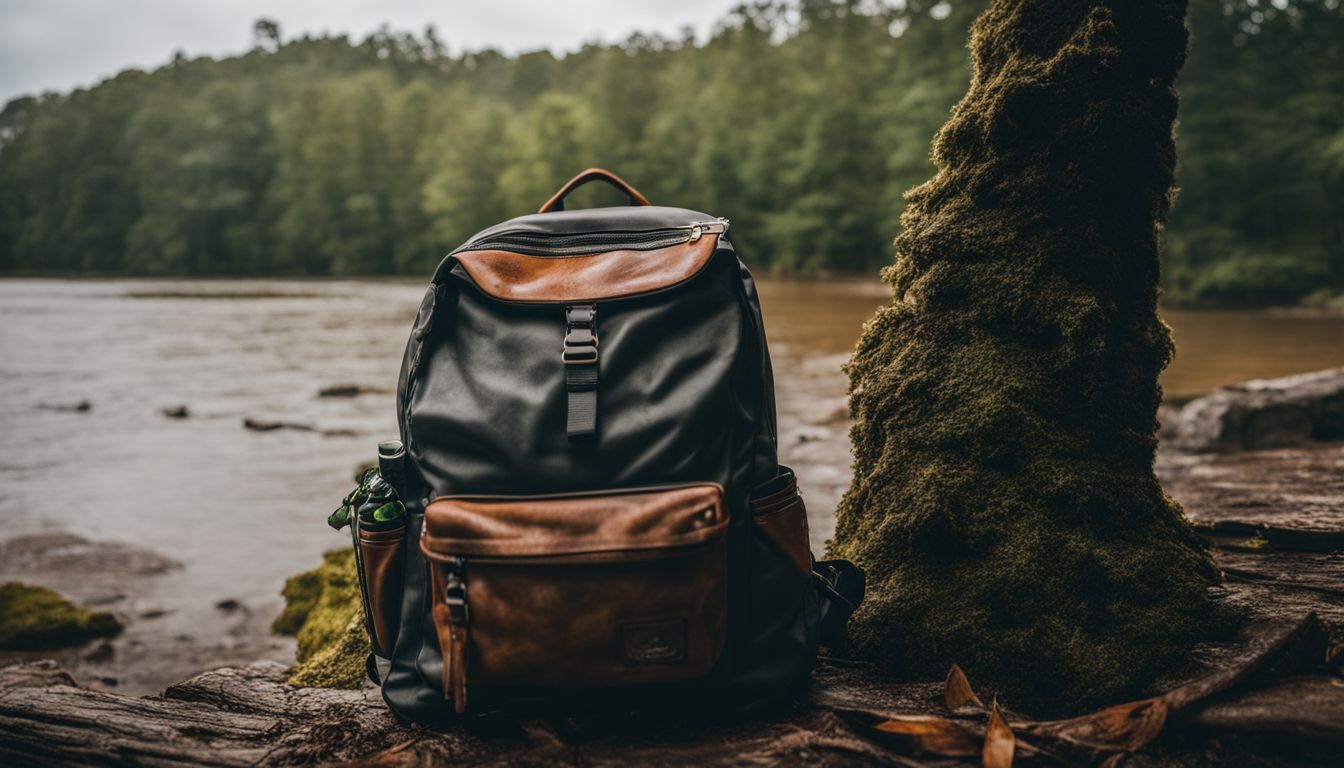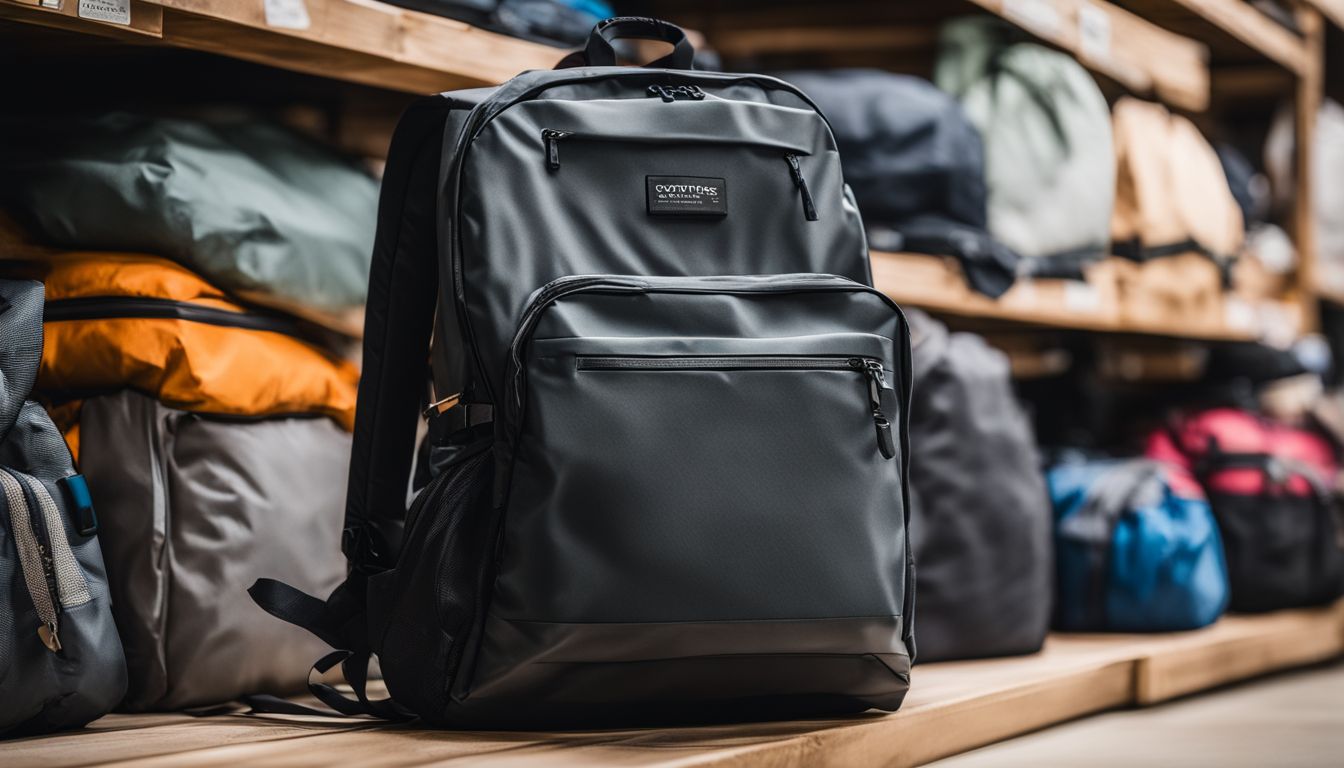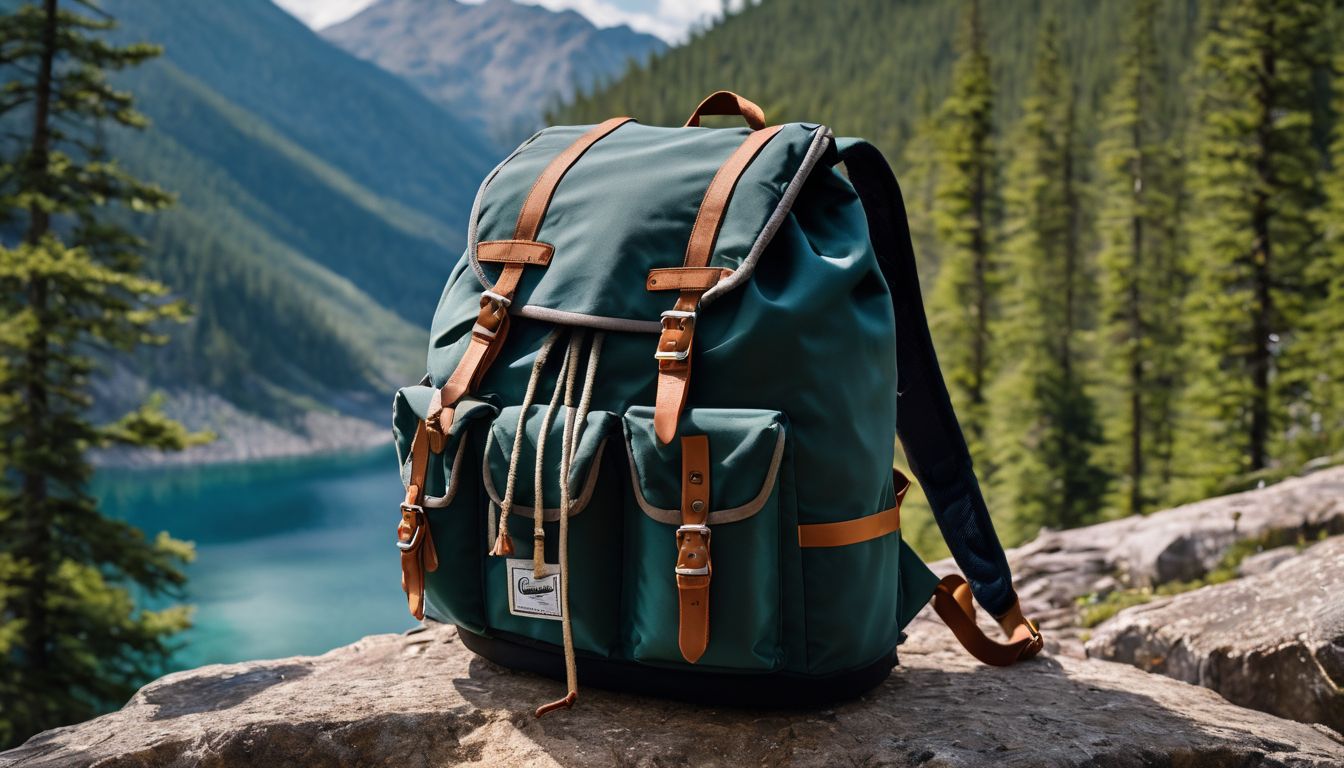The battle against mold and mildew in rucksacks is a silent struggle many outdoor enthusiasts face. Despite the adventure and thrill associated with hikes and travels, the aftermath of these excursions can lead to an unwanted intrusion in your gear: persistent fungal growth.
As someone who has journeyed through damp forests and weathered various climates, I have garnered extensive experience in maintaining the condition of backpacks.
In this article, we’ll delve into practical strategies for preventing those unsightly mold and mildew spots that compromise not just the appearance but also the integrity of your trusted rucksack.
Mold spores thrive in moisture-rich environments but fear not; you can stop them from taking over your gear with some forethought and regular care. Continue reading to unlock expert tips for keeping your travel companion pristine – it’s simpler than you might think!
Key Takeaways
- Mold and mildew thrive in damp and humid conditions, leading to musty odors, visible discoloration, and the presence of black, green, or white spots on backpack surfaces.
- Prevent mold growth by ensuring proper storage with good air circulation, prompt cleaning of any wet materials within 24-48 hours, and implementing routine cleaning schedules for backpacks.
- To remove mold from fabric backpacks, use a mixture of white vinegar or baking soda with water; denatured alcohol or saddle soap for leather backpacks; enzyme cleaner for camping gear. Properly air dry and store the cleaned backpack to prevent future mold growth.
Causes and Signs of Mold and Mildew Growth on a Backpack

Mold and mildew can develop on a backpack when it is exposed to damp or humid conditions for an extended period of time. Signs of mold and mildew growth include musty odors, visible discoloration, and the presence of black, green, or white spots on the surface of the backpack.
Mold Growth Conditions
Mold loves wet places. It can pop up around leaky spots in your house like roofs, windows, or pipes. If something gets flooded, mold might grow there too. This fungus needs some things to live: water, warm temperatures, oxygen, and food like paper or wood.
Backpacks can get moldy if they stay damp. Maybe you left it in a wet basement or forgot to air dry it after a rainy hike. Keep your backpack away from these damp spots and always make sure it’s dry before you put it away.
That will help stop mold from making your backpack its home.
Keeping your gear clean is important for stopping mold growth too. Dirt on your backpack can feed the mold. So make sure to wipe off any mud or spills as soon as possible.
Signs of Mold and Mildew
If your backpack feels damp and has a musty smell, it might be hiding some unwanted guests: mold and mildew. You can often see these as dark spots or patches that weren’t there before.
They love wet places and can show up in any little corner or fold of your bag.
Mold and mildew are not just gross; they’re bad for you too! They can make you sneeze, cough, or even itch if you touch them. If you find a stale or earthy odor coming from your rucksack, it’s time to take action.
Watch out for signs like redness on the fabric where something doesn’t seem quite right. This could mean mold is growing there without being fully seen yet. Plus, if parts of your backpack feel wetter than others or stick together when they shouldn’t – those are clues that mold might be forming.
Keep an eye out so you can stop the growth before it gets worse!
Steps to Prevent Mold and Mildew Growth

Proper storage and ventilation are essential to prevent mold and mildew growth on your backpack. Regular cleaning and maintenance should also be practiced to ensure that moisture and dirt do not accumulate, creating an environment conducive to mold growth.
Proper storage and ventilation
Keep your backpack dry and fresh by storing it in a place with lots of air moving around. This means putting it somewhere that’s not closed off, like a stuffy closet or damp basement.
Instead, choose an airy room or use a shed that has ridge vents on the roof and gable vents to let wet air out. These special vents help keep everything inside from getting musty.
Make sure your bag hangs up off the ground so air can flow all around it. Don’t let it touch walls or be squished into tight spots where air can’t reach. Think about how good airflow stops moisture from staying around, which is what mold needs to grow.
Next, we’ll talk about how to clean your backpack well to keep mold away.
Regular cleaning and maintenance
After ensuring proper storage and ventilation, regular cleaning and maintenance are crucial in preventing mold and mildew growth on your backpack. Consistent upkeep is necessary to avoid mold damage in outdoor equipment.
To achieve this, it’s essential to clean and dry any damp or wet materials within 24-48 hours to prevent mold growth. This requires prompt attention to spots that have become wet due to exposure to rain or sweat while using the backpack.
In addition, implementing a routine cleaning schedule for your backpack will help keep mold and mildew at bay. This may involve wiping down the interior and exterior of the bag with a microfiber cloth regularly.
Techniques to Remove Mold and Mildew from Different Backpack Materials
To remove mold and mildew from fabric backpacks, use a mixture of white vinegar and water or baking soda applied with a soft-bristled brush. For leather backpacks, denatured alcohol or saddle soap can be used effectively.
Camping and hiking gear may require an enzyme cleaner and thorough brushing to eliminate mold and mildew growth.
Using white vinegar or baking soda for fabric backpacks
To combat mold and mildew on fabric backpacks, white vinegar or baking soda can be your best allies. Create a solution by mixing water with either white vinegar or baking soda. Then, use a soft-bristled brush to scrub the affected areas with the solution.
Rinse thoroughly and make sure to dry the backpack completely after cleaning to prevent further mold growth. These natural remedies not only effectively remove mold but also help in preventing its recurrence.
Moving on to leather backpacks..
Using denatured alcohol or saddle soap for leather backpacks
Now let’s focus on caring for leather backpacks. When it comes to preventing mold and mildew, denatured alcohol is an excellent solution as it can effectively remove mold from leather surfaces.
A mixture of rubbing alcohol and water works well too, especially in preventing the growth of mold and mildew on leather backpacks. After cleaning with alcohol and water, conditioning the leather with a suitable cleaner such as saddle soap is crucial for maintaining its quality.
Regularly cleaning and conditioning your leather backpack will keep it free from mold and mildew. Remember that equal parts of denatured alcohol and water sprayed directly onto affected areas will eliminate any existing traces of mold or mildew.
Using a brush and enzyme cleaner for camping and hiking gear
After cleaning mold and mildew from leather backpacks, it’s important to address camping and hiking gear. When tackling camping and hiking equipment, a stiff brush is your ally in combating mildew and mold.
Brushing the gear thoroughly helps remove any visible spores or growth on the surfaces. Additionally, Gear Aid Odor Eliminator is highly recommended for eliminating mildew from camping and hiking gear.
Using this enzyme cleaner effectively gets rid of odors caused by mold while preventing their return.
White vinegar mixed with water or baking soda can be utilized to clean mold off fabric backpacks as well. These natural cleaning ingredients work wonders in removing mold without damaging the fabric material of the backpack.
Tips for Washing and Sanitizing a Moldy Backpack
Choose appropriate cleaning supplies such as white vinegar, baking soda, denatured alcohol, or saddle soap. Use disinfecting and sanitizing methods to ensure effective mold removal.
Properly air dry and store the backpack to prevent future mold growth.
Choosing appropriate cleaning supplies
To effectively clean and sanitize a moldy backpack, it’s crucial to choose the right cleaning supplies. For fabric backpacks, use a solution of white vinegar or baking soda with water.
When dealing with leather backpacks, opt for denatured alcohol or saddle soap. For camping gear, an enzyme cleaner and a brush are effective choices. It’s important to note that products like Clorox 2® for Colors 3-in-1 and Clorox® Laundry Sanitizer can be used to wash and sanitize moldy backpacks.
When considering the appropriate cleaning supplies, look for coupons which may be available for purchasing these items. This can help in acquiring quality products while being cost-effective.
Disinfecting and sanitizing methods
To effectively disinfect and sanitize a moldy backpack, start by choosing appropriate cleaning supplies such as white vinegar, baking soda, denatured alcohol, or saddle soap based on the material of the backpack.
Apply the chosen cleaning agent generously to the affected areas and use a brush to scrub away the mold and mildew. Rinse thoroughly with water and allow it to air dry completely before storing.
When sanitizing your backpack, you can use a disinfectant spray or wipes specifically designed for fabric or leather materials. Ensure that all surfaces are thoroughly covered and allow sufficient drying time before using the backpack again.
Proper air drying and storage
After disinfecting and sanitizing your backpack to remove mold and mildew, it’s crucial to focus on proper air drying and storage. Moisture is the enemy when it comes to preventing mold growth, so ensuring that the backpack is completely dry before storing it is essential.
After washing and sanitizing, hang the backpack upside down in a well-ventilated area to allow it to air dry thoroughly. It’s also important to store the backpack in a dry space with all pockets open, as this can help prevent mold and mildew growth by allowing air circulation within the compartments.
Using a fan or dehumidifier can further aid in circulating air and removing excess moisture, ultimately contributing to preventing mildew on your backpack.
In addition, keeping your backpack away from damp or humid areas such as basements will help maintain its condition. By following these simple yet effective steps for proper air drying and storage, you can greatly reduce the risk of mold and mildew taking hold of your valuable gear while extending its longevity.
Frequently Asked Questions (FAQs)
Join us as we answer common queries about backpack mold and mildew, helping you keep your gear clean and in top condition.
How to properly secure a skateboard to a backpack
To properly secure a skateboard to a backpack, slide the skateboard through the backpack straps and then tighten them securely. This will prevent the skateboard from wiggling around while you’re on the move.
For added security while traveling, consider using a cable lock through the zipper pulls on the backpack to deter theft. These steps ensure that your skateboard is safely and securely attached to your backpack for convenient transportation.
Now let’s delve into how to effectively prevent mold and mildew growth on your backpack by understanding their causes and signs, storage conditions, cleaning techniques, and washing tips.
Can a shoulder bag strap be used for everyday use?
A shoulder bag strap can absolutely be used for everyday use as it provides convenience and comfort for carrying items. The wide and adjustable straps distribute weight evenly, reducing strain on the shoulders and back.
This makes it an ideal choice for comfortably carrying essentials during daily activities or errands. Whether it’s a trip to the grocery store, commuting to work, or simply heading out for a stroll, the shoulder bag strap offers practicality without compromising style.
Utilizing a shoulder bag strap allows individuals to keep their hands free while ensuring that necessary items are easily accessible throughout the day. It’s a versatile option that suits various lifestyles and activities, providing both functionality and fashion-forward appeal.
What are concealed carry backpacks?
Can a shoulder bag strap be used for everyday use? Concealed carry backpacks are specially designed to discreetly hold firearms and provide easy access to gear. These backpacks often include dedicated compartments and holsters, allowing you to securely store your weapon while keeping it within reach if needed.
The versatility of concealed carry backpacks makes them ideal for individuals who require quick and inconspicuous access to their firearm during outdoor activities or everyday use.
These backpacks feature various organizational options, ensuring that essential items are readily accessible alongside the concealed firearm.
Concealed carry tactical backpacks offer practical and secure solutions for those who prioritize safety and preparedness. With designated pockets and compartments, these packs enable efficient organization of ammunition, personal protection equipment, and other necessary belongings without drawing attention.
How to make a secret pocket in a backpack
To create a secret pocket in your backpack, start by cutting a piece of fabric to the size you want the pocket to be. Use a tape measure and tailor’s tape to ensure accurate measurements.
Next, sew the fabric onto the inside of the backpack securely. Now you have a hidden compartment for keeping important items safe while traveling or during everyday use.
By following these simple steps, you can customize your backpack with an extra layer of security for your belongings. This DIY addition can be particularly useful for stashing valuables such as money, keys, or personal documents that you want to keep discreetly tucked away while on the go.
Making a secret pocket in your backpack allows you to have peace of mind knowing that your essentials are safely concealed and easily accessible when needed.
What is the difference between mold and mildew?
Mold is fuzzy or slimy, while mildew looks powdery or downy. Mildew forms on wet surfaces, but mold can grow anywhere. Mildew sits on top of materials, but mold can penetrate the surface.
Both start as tiny spores and thrive with excessive moisture.
How to remove mold from luggage?
After understanding the distinction between mold and mildew, it’s important to know how to remove mold from luggage. Use a stiff brush or broom over a large sheet or newspaper to detach the mold from your luggage.
Once detached, clean the luggage with white vinegar or baking soda mixed with water for effective removal. Always ensure proper air drying before storage.
Oxygen bleach can also be used in washing the luggage for better outcomes than regular bleach. Avoid using bleach directly as it can compromise moisture control, which is key in preventing mold growth on your belongings.
Conclusion
In conclusion, by following the outlined prevention and cleaning techniques, you can effectively protect your backpack from mold and mildew growth. These practical strategies are easy to implement and efficient in maintaining the integrity of your gear.
It’s crucial to understand the importance of regular maintenance to prevent damage caused by mold and mildew. Remember that taking proactive measures will lead to substantial improvements in your backpack’s condition and longevity.
If you seek further guidance or information on this topic, explore additional resources available for continued learning. Let’s embark on a journey towards a mold-free rucksack experience!
FAQs
1. How do I stop mold and mildew from growing on my rucksack?
To prevent mold and mildew, keep your rucksack dry, use leather cleaner if it’s made of leather, and store it in a cool, dry place.
2. Can I wash my rucksack to remove mold?
Yes, if your rucksack is machine washable, you can clean it in a clothes washer using cleaning products without softener or bleach.
3. What should I do after washing my rucksack to make sure no mold grows back?
After washing, put your rucksack in the dryer if the instructions say that’s okay or let it air dry completely before you use it again.
4. Are there special storage tips for keeping my backpack free from mold when not using it?
Yes! Make sure your ruck sack is totally dry then hang or store flat in a space with good air flow; don’t put damp things inside like you wouldn’t brush your teeth with a dirty toothbrush.

